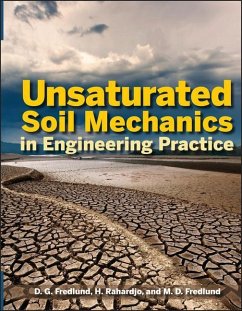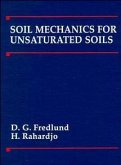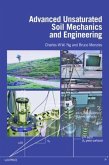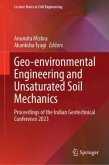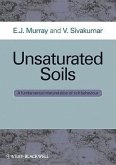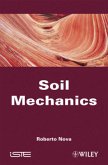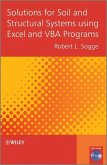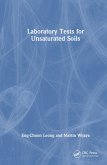Delwyn G Fredlund, Hendry Rahardjo, Murray D Fredlund
Unsaturated Soil Mechanics in Engineering Practice
Delwyn G Fredlund, Hendry Rahardjo, Murray D Fredlund
Unsaturated Soil Mechanics in Engineering Practice
- Gebundenes Buch
- Merkliste
- Auf die Merkliste
- Bewerten Bewerten
- Teilen
- Produkt teilen
- Produkterinnerung
- Produkterinnerung
The definitive guide to unsaturated soil--from the world's experts on the subject This book builds upon and substantially updates Fredlund and Rahardjo's publication, Soil Mechanics for Unsaturated Soils, the current standard in the field of unsaturated soils. It provides readers with more thorough coverage of the state of the art of unsaturated soil behavior and better reflects the manner in which practical unsaturated soil engineering problems are solved. Retaining the fundamental physics of unsaturated soil behavior presented in the earlier book, this new publication places greater emphasis…mehr
Andere Kunden interessierten sich auch für
![Soil Mechanics for Unsaturated Soils Soil Mechanics for Unsaturated Soils]() Delwyn G FredlundSoil Mechanics for Unsaturated Soils194,99 €
Delwyn G FredlundSoil Mechanics for Unsaturated Soils194,99 €![Advanced Unsaturated Soil Mechanics and Engineering Advanced Unsaturated Soil Mechanics and Engineering]() Charles Wang Wai NgAdvanced Unsaturated Soil Mechanics and Engineering289,99 €
Charles Wang Wai NgAdvanced Unsaturated Soil Mechanics and Engineering289,99 €![Geo-Environmental Engineering and Unsaturated Soil Mechanics Geo-Environmental Engineering and Unsaturated Soil Mechanics]() Geo-Environmental Engineering and Unsaturated Soil Mechanics208,99 €
Geo-Environmental Engineering and Unsaturated Soil Mechanics208,99 €![Unsaturated Soils Unsaturated Soils]() E J MurrayUnsaturated Soils124,99 €
E J MurrayUnsaturated Soils124,99 €![Soil Mechanics Soil Mechanics]() Roberto NovaSoil Mechanics235,99 €
Roberto NovaSoil Mechanics235,99 €![Solutions for Soil and Structural Systems Using Excel and VBA Programs Solutions for Soil and Structural Systems Using Excel and VBA Programs]() Robert SoggeSolutions for Soil and Structural Systems Using Excel and VBA Programs113,99 €
Robert SoggeSolutions for Soil and Structural Systems Using Excel and VBA Programs113,99 €![Laboratory Tests for Unsaturated Soils Laboratory Tests for Unsaturated Soils]() Eng-Choon LeongLaboratory Tests for Unsaturated Soils166,99 €
Eng-Choon LeongLaboratory Tests for Unsaturated Soils166,99 €-
-
-
The definitive guide to unsaturated soil--from the world's experts on the subject This book builds upon and substantially updates Fredlund and Rahardjo's publication, Soil Mechanics for Unsaturated Soils, the current standard in the field of unsaturated soils. It provides readers with more thorough coverage of the state of the art of unsaturated soil behavior and better reflects the manner in which practical unsaturated soil engineering problems are solved. Retaining the fundamental physics of unsaturated soil behavior presented in the earlier book, this new publication places greater emphasis on the importance of the "soil-water characteristic curve" in solving practical engineering problems, as well as the quantification of thermal and moisture boundary conditions based on the use of weather data. Topics covered include: * Theory to Practice of Unsaturated Soil Mechanics * Nature and Phase Properties of Unsaturated Soil * State Variables for Unsaturated Soils * Measurement and Estimation of State Variables * Soil-Water Characteristic Curves for Unsaturated Soils * Ground Surface Moisture Flux Boundary Conditions * Theory of Water Flow through Unsaturated Soils * Solving Saturated/Unsaturated Water Flow Problems * Air Flow through Unsaturated Soils * Heat Flow Analysis for Unsaturated Soils * Shear Strength of Unsaturated Soils * Shear Strength Applications in Plastic and Limit Equilibrium * Stress-Deformation Analysis for Unsaturated Soils * Solving Stress-Deformation Problems with Unsaturated Soils * Compressibility and Pore Pressure Parameters * Consolidation and Swelling Processes in Unsaturated Soils Unsaturated Soil Mechanics in Engineering Practice is essential reading for geotechnical engineers, civil engineers, and undergraduate- and graduate-level civil engineering students with a focus on soil mechanics.
Produktdetails
- Produktdetails
- Verlag: Wiley
- Seitenzahl: 944
- Erscheinungstermin: 24. Juli 2012
- Englisch
- Abmessung: 287mm x 222mm x 55mm
- Gewicht: 2404g
- ISBN-13: 9781118133590
- ISBN-10: 1118133595
- Artikelnr.: 35060485
- Herstellerkennzeichnung
- Libri GmbH
- Europaallee 1
- 36244 Bad Hersfeld
- gpsr@libri.de
- Verlag: Wiley
- Seitenzahl: 944
- Erscheinungstermin: 24. Juli 2012
- Englisch
- Abmessung: 287mm x 222mm x 55mm
- Gewicht: 2404g
- ISBN-13: 9781118133590
- ISBN-10: 1118133595
- Artikelnr.: 35060485
- Herstellerkennzeichnung
- Libri GmbH
- Europaallee 1
- 36244 Bad Hersfeld
- gpsr@libri.de
D.G. FREDLUND is the author or coauthor of over 460 refereed journal articles, conference proceedings, technical papers, and chapters in edited collections. In 1993, he coauthored Soil Mechanics for Unsaturated Soils, the first major text on unsaturated soil mechanics published. He has served as a research consultant to the Government of Hong Kong, U.S. Army Corps of Engineers, and Saskatchewan Highways, and presently is head of the Golder Unsaturated Soils Group, Canada. H. RAHARDJO is head of the Division of Infrastructure Systems and Maritime Studies at the School of Civil and Environmental Engineering at Nanyang Technological University in Singapore. He is the coauthor of Soil Mechanics for Unsaturated Soils and over 200 technical publications. M. D. FREDLUND is the President/CEO of SoilVision Systems, Canada, a geotechnical/hydrological software development and numerical modeling company.
Foreword xiii
Preface xv
Acknowledgments xvii
Chapter 1 Theory to Practice of Unsaturated Soil Mechanics 1
1.1 Introduction 1
1.2 Moisture and Thermal Flux Boundary Conditions 6
1.3 Determination of Unsaturated Soil Properties 8
1.4 Stages in Moving Toward Implementation 9
1.5 Need for Unsaturated Soil Mechanics 11
1.6 Partial Differential Equations in Soil Mechanics 17
1.7 Engineering Protocols for Unsaturated Soils 26
Chapter 2 Nature and Phase Properties of Unsaturated Soil 29
2.1 Introduction 29
2.2 Soil Classification 34
2.3 Phase Properties 48
2.4 Volume-Mass Variables 66
2.5 Soil Compaction 73
2.6 Volume-Mass Relations When Mass is Lost from System 76
Chapter 3 State Variables for Unsaturated Soils 80
3.1 Introduction 80
3.2 Basis for Stress State Variables 84
3.3 Stress State Variables for Unsaturated Soils 87
3.4 Representation of Stress States 94
3.5 Equations for Mohr Circle 98
3.6 Role of Osmotic Suction 105
Chapter 4 Measurement and Estimation of State Variables 109
4.1 Introduction 109
4.2 Measurement of Soil Suction 109
4.3 Measurement of Total Suction 149
4.4 Measurement of Osmotic Suction 164
4.5 Measurement of In Situ Water Content 165
4.6 Estimation of Soil Suction 169
Chapter 5 Soil-Water Characteristic Curves for Unsaturated Soils 184
5.1 Introduction 184
5.2 Volume-Mass Constitutive Relations 190
5.3 Equations for SWCC 200
5.4 Regression Analysis on SWCC Equations 214
5.5 Hysteresis, Initialization, and Interpretation of SWCC 217
5.6 Pham and Fredlund (2011) Equation for Entire SWCC 224
5.7 Gitirana and Fredlund (2004) SWCC 231
5.8 Measurement of SWCC Using Pressure Plate Devices 234
5.9 Single-Specimen Pressure Plate Devices for Geotechnical Engineering 242
5.10 Vacuum Desiccators for High Suctions 249
5.11 Use of Chilled-Mirror or Dew-Point Method 251
5.12 Estimation of SWCC 253
5.13 Two-Point Method of Estimating SWCC 263
5.14 Correlation of Fitting Parameters to Soil Properties 265
5.15 Application of SWCC 269
5.16 Guidelines and Recommendations for Engineering Practice 271
Chapter 6 Ground Surface Moisture Flux Boundary Conditions 273
6.1 Introduction 273
6.2 Climatic Classification for a Site 274
6.3 Boundary Value Framework for Near-Ground-Surface Design 278
6.4 Challenges of Numerical Modeling Ground Surface Moisture Flux
Conditions 321
Chapter 7 Theory of Water Flow through Unsaturated Soils 327
7.1 Introduction 327
7.2 Theory of Flow of Water 327
7.3 Darcy's Law for Unsaturated Soils 331
7.4 Partial Differential Equations for Steady-State Water Flow 344
7.5 Partial Differential Equations for Transient Seepage 351
7.6 Direct Measurement of Water Flow Properties 354
Chapter 8 Solving Saturated/Unsaturated Water Flow Problems 375
8.1 Introduction 375
8.2 Estimation of Permeability Function 375
8.3 Application to Saturated-Unsaturated Water Flow Problems 397
8.4 Conditions under Which Matric Suction Can Be Maintained 437
Chapter 9 Air Flow through Unsaturated Soils 450
9.1 Introduction 450
9.2 Theory of Free Air Flow 450
9.3 Fick's Law and Darcy's Law for Air Flow 451
9.4 Diffusion of Air through Water 458
9.5 Other Components of Air Flow 460
9.6 Partial Differential Equations for Air Flow through Unsaturated Soils
461
9.7 Direct Measurement of Air Coefficient of Permeability 465
9.8 Direct Measurement of Air Diffusion through Water 467
9.9 Indirect Estimation of Air Flow Properties 472
9.10 Applications to Saturated-Unsaturated Air Flow Problems 480
Chapter 10 Heat Flow Analysis for Unsaturated Soils 487
10.1 Introduction 487
10.2 Theory of Heat Flow 488
10.3 Theory of Freezing and Thawing Soils 492
10.4 Formulation of Partial Differential Equations for Conductive Heat Flow
495
10.5 Direct Measurement of Thermal Properties 500
10.6 Estimation Procedures for Thermal Properties 505
10.7 Applications to Thermal Problems 510
10.8 One-Dimensional Heat Flow in Unfrozen and Frozen Soils 511
10.9 Two-Dimensional Heat Flow Example Involving Chilled Pipeline 511
10.10 Two-Dimensional Heat Flow Example with Surface Temperatures above and
below Freezing 512
10.11 Aldrich (1956) Example of Vertical Column 516
Chapter 11 Shear Strength of Unsaturated Soils 520
11.1 Introduction 520
11.2 Theory of Shear Strength 520
11.3 Measurement of Shear Strength 536
11.4 Special Equipment Design Considerations 541
11.5 Triaxial Test Procedures for Unsaturated Soils 551
11.6 Interpretation of Triaxial Test Results 554
11.7 Direct Shear Tests 565
11.8 Typical Laboratory Test Results 567
11.9 Selection of Strain Rate 578
Chapter 12 Shear Strength Applications in Plastic and Limit Equilibrium 588
12.1 Introduction 588
12.2 Estimation of Shear Strength Functions for Unsaturated Soils 588
12.3 Application to Practical Shear Strength Problems in Geotechnical
Engineering 612
12.4 Bearing Capacity 626
12.5 Slope Stability 632
12.6 Optimization Procedures to Solve for Factor of Safety 642
12.7 Application of Slope Stability Analyses 651
12.8 Hazard Assessment and Decision Analysis Related to Slope Instability
662
Chapter 13 Stress-Deformation Analysis for Unsaturated Soils 666
13.1 Introduction 666
13.2 Concepts of Volume Change and Deformation 670
13.3 Volume-Mass Constitutive Relations 673
13.4 Compressibility Form for Unsaturated Soil Constitutive Relations 679
13.5 Relationship Among Volumetric Deformation Coefficients 685
13.6 Pham-Fredlund Volume-Mass Constitutive Mode (2011a) 693
13.7 Formulation of Partial Differential Equations for Stress-Deformation
in Unsaturated Soils 713
13.8 Measurement of Stress-Deformation Properties for Unsaturated Soils 721
Chapter 14 Solving Stress-Deformation Problems with Unsaturated Soils 731
14.1 Introduction 731
14.2 Estimation of Stress-Deformation Properties 731
14.3 Application to Practical Stress-Deformation Problems 735
14.4 Evaluation of Stress History in Unsaturated Soils 738
14.5 One-Dimensional Formulations for Deformation Analysis for Unsaturated
Soil 756
14.6 Swelling Theory Formulated in Terms of Incremental Elasticity
Parameters 768
14.7 Evaluation of Elasticity Parameter Functions from Volume Change
Indices 771
14.8 One-Dimensional Solution Using Incremental Elasticity Formulation 775
14.9 Two-Dimensional Solution Using Incremental Elasticity Formulation 778
14.10 Challenges in Numerically Modeling of Expansive Soil Problems 778
Chapter 15 Compressibility and Pore Pressure Parameters 783
15.1 Introduction 783
15.2 Coupled and Uncoupled Solutions 784
15.3 Uncoupled Undrained Loading 786
15.4 Derivation of Pore Pressure Parameters 794
15.5 Drained and Undrained Loading 796
15.6 Solutions of Pore Pressure Equations and Comparisons with Experimental
Results 802
15.7 Rheological Model to Represent Relative Compressibilities of
Unsaturated Soil 807
Chapter 16 Consolidation and Swelling Processes in Unsaturated Soils 809
16.1 Introduction 809
16.2 Stress and Seepage Uncoupled and Coupled Systems 809
16.3 Solution of Consolidation Equations Using Finite Difference Technique
817
16.4 Typical Consolidation Test Results on Unsaturated Soils 819
16.5 Dimensionless Consolidation Parameters 823
16.6 Coupled Formulations and Three-Dimensional Consolidation 825
16.7 Water, Air Flow, and Nonisothermal Systems 829
16.8 Two-Dimensional Stress-Deformation and Saturated-Unsaturated Seepage
Analysis 831
16.9 Computer Simulation of Edge Lift and Edge Drop of Slabs-on-Ground 845
16.10 Theory for Simulation of Swelling Pressure Development 848
16.11 Rheological Model for Unsaturated Soils 851
Appendix Units and Symbols 858
References 864
Index 911
Preface xv
Acknowledgments xvii
Chapter 1 Theory to Practice of Unsaturated Soil Mechanics 1
1.1 Introduction 1
1.2 Moisture and Thermal Flux Boundary Conditions 6
1.3 Determination of Unsaturated Soil Properties 8
1.4 Stages in Moving Toward Implementation 9
1.5 Need for Unsaturated Soil Mechanics 11
1.6 Partial Differential Equations in Soil Mechanics 17
1.7 Engineering Protocols for Unsaturated Soils 26
Chapter 2 Nature and Phase Properties of Unsaturated Soil 29
2.1 Introduction 29
2.2 Soil Classification 34
2.3 Phase Properties 48
2.4 Volume-Mass Variables 66
2.5 Soil Compaction 73
2.6 Volume-Mass Relations When Mass is Lost from System 76
Chapter 3 State Variables for Unsaturated Soils 80
3.1 Introduction 80
3.2 Basis for Stress State Variables 84
3.3 Stress State Variables for Unsaturated Soils 87
3.4 Representation of Stress States 94
3.5 Equations for Mohr Circle 98
3.6 Role of Osmotic Suction 105
Chapter 4 Measurement and Estimation of State Variables 109
4.1 Introduction 109
4.2 Measurement of Soil Suction 109
4.3 Measurement of Total Suction 149
4.4 Measurement of Osmotic Suction 164
4.5 Measurement of In Situ Water Content 165
4.6 Estimation of Soil Suction 169
Chapter 5 Soil-Water Characteristic Curves for Unsaturated Soils 184
5.1 Introduction 184
5.2 Volume-Mass Constitutive Relations 190
5.3 Equations for SWCC 200
5.4 Regression Analysis on SWCC Equations 214
5.5 Hysteresis, Initialization, and Interpretation of SWCC 217
5.6 Pham and Fredlund (2011) Equation for Entire SWCC 224
5.7 Gitirana and Fredlund (2004) SWCC 231
5.8 Measurement of SWCC Using Pressure Plate Devices 234
5.9 Single-Specimen Pressure Plate Devices for Geotechnical Engineering 242
5.10 Vacuum Desiccators for High Suctions 249
5.11 Use of Chilled-Mirror or Dew-Point Method 251
5.12 Estimation of SWCC 253
5.13 Two-Point Method of Estimating SWCC 263
5.14 Correlation of Fitting Parameters to Soil Properties 265
5.15 Application of SWCC 269
5.16 Guidelines and Recommendations for Engineering Practice 271
Chapter 6 Ground Surface Moisture Flux Boundary Conditions 273
6.1 Introduction 273
6.2 Climatic Classification for a Site 274
6.3 Boundary Value Framework for Near-Ground-Surface Design 278
6.4 Challenges of Numerical Modeling Ground Surface Moisture Flux
Conditions 321
Chapter 7 Theory of Water Flow through Unsaturated Soils 327
7.1 Introduction 327
7.2 Theory of Flow of Water 327
7.3 Darcy's Law for Unsaturated Soils 331
7.4 Partial Differential Equations for Steady-State Water Flow 344
7.5 Partial Differential Equations for Transient Seepage 351
7.6 Direct Measurement of Water Flow Properties 354
Chapter 8 Solving Saturated/Unsaturated Water Flow Problems 375
8.1 Introduction 375
8.2 Estimation of Permeability Function 375
8.3 Application to Saturated-Unsaturated Water Flow Problems 397
8.4 Conditions under Which Matric Suction Can Be Maintained 437
Chapter 9 Air Flow through Unsaturated Soils 450
9.1 Introduction 450
9.2 Theory of Free Air Flow 450
9.3 Fick's Law and Darcy's Law for Air Flow 451
9.4 Diffusion of Air through Water 458
9.5 Other Components of Air Flow 460
9.6 Partial Differential Equations for Air Flow through Unsaturated Soils
461
9.7 Direct Measurement of Air Coefficient of Permeability 465
9.8 Direct Measurement of Air Diffusion through Water 467
9.9 Indirect Estimation of Air Flow Properties 472
9.10 Applications to Saturated-Unsaturated Air Flow Problems 480
Chapter 10 Heat Flow Analysis for Unsaturated Soils 487
10.1 Introduction 487
10.2 Theory of Heat Flow 488
10.3 Theory of Freezing and Thawing Soils 492
10.4 Formulation of Partial Differential Equations for Conductive Heat Flow
495
10.5 Direct Measurement of Thermal Properties 500
10.6 Estimation Procedures for Thermal Properties 505
10.7 Applications to Thermal Problems 510
10.8 One-Dimensional Heat Flow in Unfrozen and Frozen Soils 511
10.9 Two-Dimensional Heat Flow Example Involving Chilled Pipeline 511
10.10 Two-Dimensional Heat Flow Example with Surface Temperatures above and
below Freezing 512
10.11 Aldrich (1956) Example of Vertical Column 516
Chapter 11 Shear Strength of Unsaturated Soils 520
11.1 Introduction 520
11.2 Theory of Shear Strength 520
11.3 Measurement of Shear Strength 536
11.4 Special Equipment Design Considerations 541
11.5 Triaxial Test Procedures for Unsaturated Soils 551
11.6 Interpretation of Triaxial Test Results 554
11.7 Direct Shear Tests 565
11.8 Typical Laboratory Test Results 567
11.9 Selection of Strain Rate 578
Chapter 12 Shear Strength Applications in Plastic and Limit Equilibrium 588
12.1 Introduction 588
12.2 Estimation of Shear Strength Functions for Unsaturated Soils 588
12.3 Application to Practical Shear Strength Problems in Geotechnical
Engineering 612
12.4 Bearing Capacity 626
12.5 Slope Stability 632
12.6 Optimization Procedures to Solve for Factor of Safety 642
12.7 Application of Slope Stability Analyses 651
12.8 Hazard Assessment and Decision Analysis Related to Slope Instability
662
Chapter 13 Stress-Deformation Analysis for Unsaturated Soils 666
13.1 Introduction 666
13.2 Concepts of Volume Change and Deformation 670
13.3 Volume-Mass Constitutive Relations 673
13.4 Compressibility Form for Unsaturated Soil Constitutive Relations 679
13.5 Relationship Among Volumetric Deformation Coefficients 685
13.6 Pham-Fredlund Volume-Mass Constitutive Mode (2011a) 693
13.7 Formulation of Partial Differential Equations for Stress-Deformation
in Unsaturated Soils 713
13.8 Measurement of Stress-Deformation Properties for Unsaturated Soils 721
Chapter 14 Solving Stress-Deformation Problems with Unsaturated Soils 731
14.1 Introduction 731
14.2 Estimation of Stress-Deformation Properties 731
14.3 Application to Practical Stress-Deformation Problems 735
14.4 Evaluation of Stress History in Unsaturated Soils 738
14.5 One-Dimensional Formulations for Deformation Analysis for Unsaturated
Soil 756
14.6 Swelling Theory Formulated in Terms of Incremental Elasticity
Parameters 768
14.7 Evaluation of Elasticity Parameter Functions from Volume Change
Indices 771
14.8 One-Dimensional Solution Using Incremental Elasticity Formulation 775
14.9 Two-Dimensional Solution Using Incremental Elasticity Formulation 778
14.10 Challenges in Numerically Modeling of Expansive Soil Problems 778
Chapter 15 Compressibility and Pore Pressure Parameters 783
15.1 Introduction 783
15.2 Coupled and Uncoupled Solutions 784
15.3 Uncoupled Undrained Loading 786
15.4 Derivation of Pore Pressure Parameters 794
15.5 Drained and Undrained Loading 796
15.6 Solutions of Pore Pressure Equations and Comparisons with Experimental
Results 802
15.7 Rheological Model to Represent Relative Compressibilities of
Unsaturated Soil 807
Chapter 16 Consolidation and Swelling Processes in Unsaturated Soils 809
16.1 Introduction 809
16.2 Stress and Seepage Uncoupled and Coupled Systems 809
16.3 Solution of Consolidation Equations Using Finite Difference Technique
817
16.4 Typical Consolidation Test Results on Unsaturated Soils 819
16.5 Dimensionless Consolidation Parameters 823
16.6 Coupled Formulations and Three-Dimensional Consolidation 825
16.7 Water, Air Flow, and Nonisothermal Systems 829
16.8 Two-Dimensional Stress-Deformation and Saturated-Unsaturated Seepage
Analysis 831
16.9 Computer Simulation of Edge Lift and Edge Drop of Slabs-on-Ground 845
16.10 Theory for Simulation of Swelling Pressure Development 848
16.11 Rheological Model for Unsaturated Soils 851
Appendix Units and Symbols 858
References 864
Index 911
Foreword xiii
Preface xv
Acknowledgments xvii
Chapter 1 Theory to Practice of Unsaturated Soil Mechanics 1
1.1 Introduction 1
1.2 Moisture and Thermal Flux Boundary Conditions 6
1.3 Determination of Unsaturated Soil Properties 8
1.4 Stages in Moving Toward Implementation 9
1.5 Need for Unsaturated Soil Mechanics 11
1.6 Partial Differential Equations in Soil Mechanics 17
1.7 Engineering Protocols for Unsaturated Soils 26
Chapter 2 Nature and Phase Properties of Unsaturated Soil 29
2.1 Introduction 29
2.2 Soil Classification 34
2.3 Phase Properties 48
2.4 Volume-Mass Variables 66
2.5 Soil Compaction 73
2.6 Volume-Mass Relations When Mass is Lost from System 76
Chapter 3 State Variables for Unsaturated Soils 80
3.1 Introduction 80
3.2 Basis for Stress State Variables 84
3.3 Stress State Variables for Unsaturated Soils 87
3.4 Representation of Stress States 94
3.5 Equations for Mohr Circle 98
3.6 Role of Osmotic Suction 105
Chapter 4 Measurement and Estimation of State Variables 109
4.1 Introduction 109
4.2 Measurement of Soil Suction 109
4.3 Measurement of Total Suction 149
4.4 Measurement of Osmotic Suction 164
4.5 Measurement of In Situ Water Content 165
4.6 Estimation of Soil Suction 169
Chapter 5 Soil-Water Characteristic Curves for Unsaturated Soils 184
5.1 Introduction 184
5.2 Volume-Mass Constitutive Relations 190
5.3 Equations for SWCC 200
5.4 Regression Analysis on SWCC Equations 214
5.5 Hysteresis, Initialization, and Interpretation of SWCC 217
5.6 Pham and Fredlund (2011) Equation for Entire SWCC 224
5.7 Gitirana and Fredlund (2004) SWCC 231
5.8 Measurement of SWCC Using Pressure Plate Devices 234
5.9 Single-Specimen Pressure Plate Devices for Geotechnical Engineering 242
5.10 Vacuum Desiccators for High Suctions 249
5.11 Use of Chilled-Mirror or Dew-Point Method 251
5.12 Estimation of SWCC 253
5.13 Two-Point Method of Estimating SWCC 263
5.14 Correlation of Fitting Parameters to Soil Properties 265
5.15 Application of SWCC 269
5.16 Guidelines and Recommendations for Engineering Practice 271
Chapter 6 Ground Surface Moisture Flux Boundary Conditions 273
6.1 Introduction 273
6.2 Climatic Classification for a Site 274
6.3 Boundary Value Framework for Near-Ground-Surface Design 278
6.4 Challenges of Numerical Modeling Ground Surface Moisture Flux
Conditions 321
Chapter 7 Theory of Water Flow through Unsaturated Soils 327
7.1 Introduction 327
7.2 Theory of Flow of Water 327
7.3 Darcy's Law for Unsaturated Soils 331
7.4 Partial Differential Equations for Steady-State Water Flow 344
7.5 Partial Differential Equations for Transient Seepage 351
7.6 Direct Measurement of Water Flow Properties 354
Chapter 8 Solving Saturated/Unsaturated Water Flow Problems 375
8.1 Introduction 375
8.2 Estimation of Permeability Function 375
8.3 Application to Saturated-Unsaturated Water Flow Problems 397
8.4 Conditions under Which Matric Suction Can Be Maintained 437
Chapter 9 Air Flow through Unsaturated Soils 450
9.1 Introduction 450
9.2 Theory of Free Air Flow 450
9.3 Fick's Law and Darcy's Law for Air Flow 451
9.4 Diffusion of Air through Water 458
9.5 Other Components of Air Flow 460
9.6 Partial Differential Equations for Air Flow through Unsaturated Soils
461
9.7 Direct Measurement of Air Coefficient of Permeability 465
9.8 Direct Measurement of Air Diffusion through Water 467
9.9 Indirect Estimation of Air Flow Properties 472
9.10 Applications to Saturated-Unsaturated Air Flow Problems 480
Chapter 10 Heat Flow Analysis for Unsaturated Soils 487
10.1 Introduction 487
10.2 Theory of Heat Flow 488
10.3 Theory of Freezing and Thawing Soils 492
10.4 Formulation of Partial Differential Equations for Conductive Heat Flow
495
10.5 Direct Measurement of Thermal Properties 500
10.6 Estimation Procedures for Thermal Properties 505
10.7 Applications to Thermal Problems 510
10.8 One-Dimensional Heat Flow in Unfrozen and Frozen Soils 511
10.9 Two-Dimensional Heat Flow Example Involving Chilled Pipeline 511
10.10 Two-Dimensional Heat Flow Example with Surface Temperatures above and
below Freezing 512
10.11 Aldrich (1956) Example of Vertical Column 516
Chapter 11 Shear Strength of Unsaturated Soils 520
11.1 Introduction 520
11.2 Theory of Shear Strength 520
11.3 Measurement of Shear Strength 536
11.4 Special Equipment Design Considerations 541
11.5 Triaxial Test Procedures for Unsaturated Soils 551
11.6 Interpretation of Triaxial Test Results 554
11.7 Direct Shear Tests 565
11.8 Typical Laboratory Test Results 567
11.9 Selection of Strain Rate 578
Chapter 12 Shear Strength Applications in Plastic and Limit Equilibrium 588
12.1 Introduction 588
12.2 Estimation of Shear Strength Functions for Unsaturated Soils 588
12.3 Application to Practical Shear Strength Problems in Geotechnical
Engineering 612
12.4 Bearing Capacity 626
12.5 Slope Stability 632
12.6 Optimization Procedures to Solve for Factor of Safety 642
12.7 Application of Slope Stability Analyses 651
12.8 Hazard Assessment and Decision Analysis Related to Slope Instability
662
Chapter 13 Stress-Deformation Analysis for Unsaturated Soils 666
13.1 Introduction 666
13.2 Concepts of Volume Change and Deformation 670
13.3 Volume-Mass Constitutive Relations 673
13.4 Compressibility Form for Unsaturated Soil Constitutive Relations 679
13.5 Relationship Among Volumetric Deformation Coefficients 685
13.6 Pham-Fredlund Volume-Mass Constitutive Mode (2011a) 693
13.7 Formulation of Partial Differential Equations for Stress-Deformation
in Unsaturated Soils 713
13.8 Measurement of Stress-Deformation Properties for Unsaturated Soils 721
Chapter 14 Solving Stress-Deformation Problems with Unsaturated Soils 731
14.1 Introduction 731
14.2 Estimation of Stress-Deformation Properties 731
14.3 Application to Practical Stress-Deformation Problems 735
14.4 Evaluation of Stress History in Unsaturated Soils 738
14.5 One-Dimensional Formulations for Deformation Analysis for Unsaturated
Soil 756
14.6 Swelling Theory Formulated in Terms of Incremental Elasticity
Parameters 768
14.7 Evaluation of Elasticity Parameter Functions from Volume Change
Indices 771
14.8 One-Dimensional Solution Using Incremental Elasticity Formulation 775
14.9 Two-Dimensional Solution Using Incremental Elasticity Formulation 778
14.10 Challenges in Numerically Modeling of Expansive Soil Problems 778
Chapter 15 Compressibility and Pore Pressure Parameters 783
15.1 Introduction 783
15.2 Coupled and Uncoupled Solutions 784
15.3 Uncoupled Undrained Loading 786
15.4 Derivation of Pore Pressure Parameters 794
15.5 Drained and Undrained Loading 796
15.6 Solutions of Pore Pressure Equations and Comparisons with Experimental
Results 802
15.7 Rheological Model to Represent Relative Compressibilities of
Unsaturated Soil 807
Chapter 16 Consolidation and Swelling Processes in Unsaturated Soils 809
16.1 Introduction 809
16.2 Stress and Seepage Uncoupled and Coupled Systems 809
16.3 Solution of Consolidation Equations Using Finite Difference Technique
817
16.4 Typical Consolidation Test Results on Unsaturated Soils 819
16.5 Dimensionless Consolidation Parameters 823
16.6 Coupled Formulations and Three-Dimensional Consolidation 825
16.7 Water, Air Flow, and Nonisothermal Systems 829
16.8 Two-Dimensional Stress-Deformation and Saturated-Unsaturated Seepage
Analysis 831
16.9 Computer Simulation of Edge Lift and Edge Drop of Slabs-on-Ground 845
16.10 Theory for Simulation of Swelling Pressure Development 848
16.11 Rheological Model for Unsaturated Soils 851
Appendix Units and Symbols 858
References 864
Index 911
Preface xv
Acknowledgments xvii
Chapter 1 Theory to Practice of Unsaturated Soil Mechanics 1
1.1 Introduction 1
1.2 Moisture and Thermal Flux Boundary Conditions 6
1.3 Determination of Unsaturated Soil Properties 8
1.4 Stages in Moving Toward Implementation 9
1.5 Need for Unsaturated Soil Mechanics 11
1.6 Partial Differential Equations in Soil Mechanics 17
1.7 Engineering Protocols for Unsaturated Soils 26
Chapter 2 Nature and Phase Properties of Unsaturated Soil 29
2.1 Introduction 29
2.2 Soil Classification 34
2.3 Phase Properties 48
2.4 Volume-Mass Variables 66
2.5 Soil Compaction 73
2.6 Volume-Mass Relations When Mass is Lost from System 76
Chapter 3 State Variables for Unsaturated Soils 80
3.1 Introduction 80
3.2 Basis for Stress State Variables 84
3.3 Stress State Variables for Unsaturated Soils 87
3.4 Representation of Stress States 94
3.5 Equations for Mohr Circle 98
3.6 Role of Osmotic Suction 105
Chapter 4 Measurement and Estimation of State Variables 109
4.1 Introduction 109
4.2 Measurement of Soil Suction 109
4.3 Measurement of Total Suction 149
4.4 Measurement of Osmotic Suction 164
4.5 Measurement of In Situ Water Content 165
4.6 Estimation of Soil Suction 169
Chapter 5 Soil-Water Characteristic Curves for Unsaturated Soils 184
5.1 Introduction 184
5.2 Volume-Mass Constitutive Relations 190
5.3 Equations for SWCC 200
5.4 Regression Analysis on SWCC Equations 214
5.5 Hysteresis, Initialization, and Interpretation of SWCC 217
5.6 Pham and Fredlund (2011) Equation for Entire SWCC 224
5.7 Gitirana and Fredlund (2004) SWCC 231
5.8 Measurement of SWCC Using Pressure Plate Devices 234
5.9 Single-Specimen Pressure Plate Devices for Geotechnical Engineering 242
5.10 Vacuum Desiccators for High Suctions 249
5.11 Use of Chilled-Mirror or Dew-Point Method 251
5.12 Estimation of SWCC 253
5.13 Two-Point Method of Estimating SWCC 263
5.14 Correlation of Fitting Parameters to Soil Properties 265
5.15 Application of SWCC 269
5.16 Guidelines and Recommendations for Engineering Practice 271
Chapter 6 Ground Surface Moisture Flux Boundary Conditions 273
6.1 Introduction 273
6.2 Climatic Classification for a Site 274
6.3 Boundary Value Framework for Near-Ground-Surface Design 278
6.4 Challenges of Numerical Modeling Ground Surface Moisture Flux
Conditions 321
Chapter 7 Theory of Water Flow through Unsaturated Soils 327
7.1 Introduction 327
7.2 Theory of Flow of Water 327
7.3 Darcy's Law for Unsaturated Soils 331
7.4 Partial Differential Equations for Steady-State Water Flow 344
7.5 Partial Differential Equations for Transient Seepage 351
7.6 Direct Measurement of Water Flow Properties 354
Chapter 8 Solving Saturated/Unsaturated Water Flow Problems 375
8.1 Introduction 375
8.2 Estimation of Permeability Function 375
8.3 Application to Saturated-Unsaturated Water Flow Problems 397
8.4 Conditions under Which Matric Suction Can Be Maintained 437
Chapter 9 Air Flow through Unsaturated Soils 450
9.1 Introduction 450
9.2 Theory of Free Air Flow 450
9.3 Fick's Law and Darcy's Law for Air Flow 451
9.4 Diffusion of Air through Water 458
9.5 Other Components of Air Flow 460
9.6 Partial Differential Equations for Air Flow through Unsaturated Soils
461
9.7 Direct Measurement of Air Coefficient of Permeability 465
9.8 Direct Measurement of Air Diffusion through Water 467
9.9 Indirect Estimation of Air Flow Properties 472
9.10 Applications to Saturated-Unsaturated Air Flow Problems 480
Chapter 10 Heat Flow Analysis for Unsaturated Soils 487
10.1 Introduction 487
10.2 Theory of Heat Flow 488
10.3 Theory of Freezing and Thawing Soils 492
10.4 Formulation of Partial Differential Equations for Conductive Heat Flow
495
10.5 Direct Measurement of Thermal Properties 500
10.6 Estimation Procedures for Thermal Properties 505
10.7 Applications to Thermal Problems 510
10.8 One-Dimensional Heat Flow in Unfrozen and Frozen Soils 511
10.9 Two-Dimensional Heat Flow Example Involving Chilled Pipeline 511
10.10 Two-Dimensional Heat Flow Example with Surface Temperatures above and
below Freezing 512
10.11 Aldrich (1956) Example of Vertical Column 516
Chapter 11 Shear Strength of Unsaturated Soils 520
11.1 Introduction 520
11.2 Theory of Shear Strength 520
11.3 Measurement of Shear Strength 536
11.4 Special Equipment Design Considerations 541
11.5 Triaxial Test Procedures for Unsaturated Soils 551
11.6 Interpretation of Triaxial Test Results 554
11.7 Direct Shear Tests 565
11.8 Typical Laboratory Test Results 567
11.9 Selection of Strain Rate 578
Chapter 12 Shear Strength Applications in Plastic and Limit Equilibrium 588
12.1 Introduction 588
12.2 Estimation of Shear Strength Functions for Unsaturated Soils 588
12.3 Application to Practical Shear Strength Problems in Geotechnical
Engineering 612
12.4 Bearing Capacity 626
12.5 Slope Stability 632
12.6 Optimization Procedures to Solve for Factor of Safety 642
12.7 Application of Slope Stability Analyses 651
12.8 Hazard Assessment and Decision Analysis Related to Slope Instability
662
Chapter 13 Stress-Deformation Analysis for Unsaturated Soils 666
13.1 Introduction 666
13.2 Concepts of Volume Change and Deformation 670
13.3 Volume-Mass Constitutive Relations 673
13.4 Compressibility Form for Unsaturated Soil Constitutive Relations 679
13.5 Relationship Among Volumetric Deformation Coefficients 685
13.6 Pham-Fredlund Volume-Mass Constitutive Mode (2011a) 693
13.7 Formulation of Partial Differential Equations for Stress-Deformation
in Unsaturated Soils 713
13.8 Measurement of Stress-Deformation Properties for Unsaturated Soils 721
Chapter 14 Solving Stress-Deformation Problems with Unsaturated Soils 731
14.1 Introduction 731
14.2 Estimation of Stress-Deformation Properties 731
14.3 Application to Practical Stress-Deformation Problems 735
14.4 Evaluation of Stress History in Unsaturated Soils 738
14.5 One-Dimensional Formulations for Deformation Analysis for Unsaturated
Soil 756
14.6 Swelling Theory Formulated in Terms of Incremental Elasticity
Parameters 768
14.7 Evaluation of Elasticity Parameter Functions from Volume Change
Indices 771
14.8 One-Dimensional Solution Using Incremental Elasticity Formulation 775
14.9 Two-Dimensional Solution Using Incremental Elasticity Formulation 778
14.10 Challenges in Numerically Modeling of Expansive Soil Problems 778
Chapter 15 Compressibility and Pore Pressure Parameters 783
15.1 Introduction 783
15.2 Coupled and Uncoupled Solutions 784
15.3 Uncoupled Undrained Loading 786
15.4 Derivation of Pore Pressure Parameters 794
15.5 Drained and Undrained Loading 796
15.6 Solutions of Pore Pressure Equations and Comparisons with Experimental
Results 802
15.7 Rheological Model to Represent Relative Compressibilities of
Unsaturated Soil 807
Chapter 16 Consolidation and Swelling Processes in Unsaturated Soils 809
16.1 Introduction 809
16.2 Stress and Seepage Uncoupled and Coupled Systems 809
16.3 Solution of Consolidation Equations Using Finite Difference Technique
817
16.4 Typical Consolidation Test Results on Unsaturated Soils 819
16.5 Dimensionless Consolidation Parameters 823
16.6 Coupled Formulations and Three-Dimensional Consolidation 825
16.7 Water, Air Flow, and Nonisothermal Systems 829
16.8 Two-Dimensional Stress-Deformation and Saturated-Unsaturated Seepage
Analysis 831
16.9 Computer Simulation of Edge Lift and Edge Drop of Slabs-on-Ground 845
16.10 Theory for Simulation of Swelling Pressure Development 848
16.11 Rheological Model for Unsaturated Soils 851
Appendix Units and Symbols 858
References 864
Index 911

